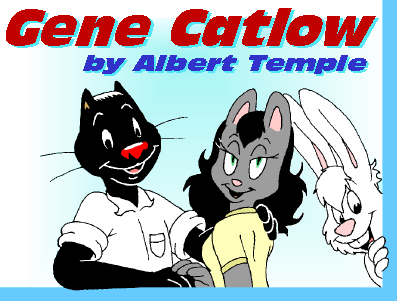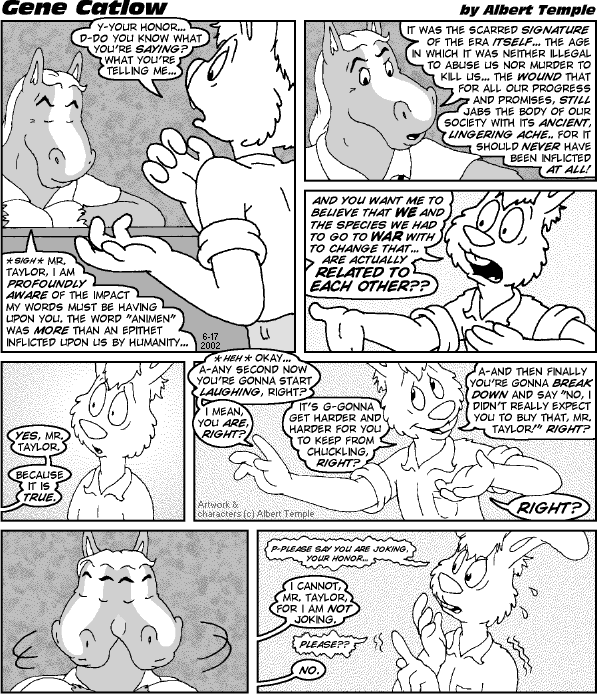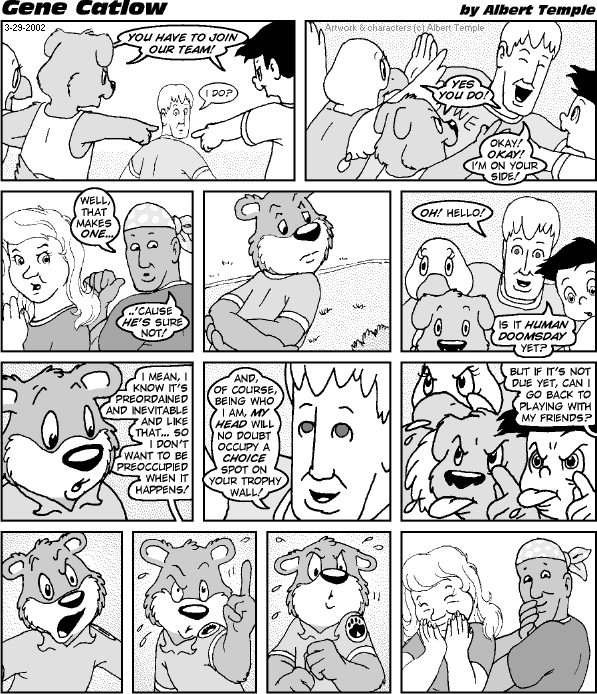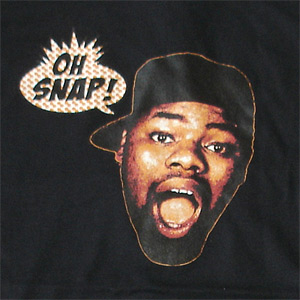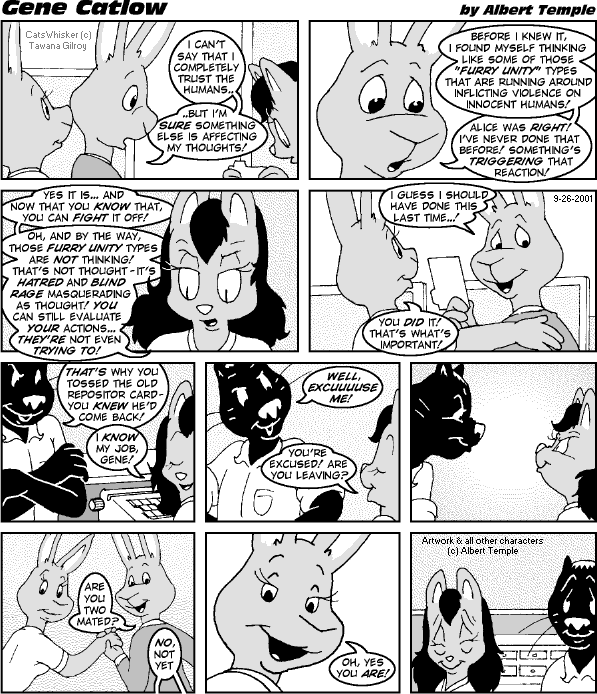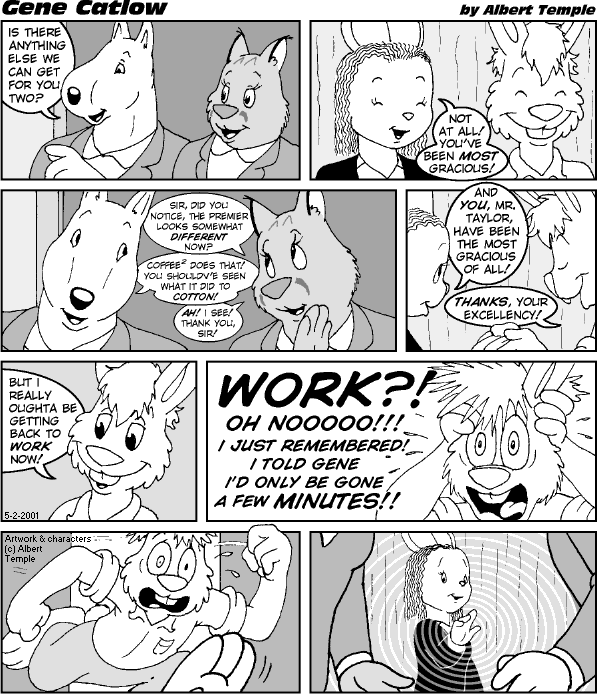Through works as varied as James Cameron’s Avatar, Ferngully and certain elements of The Lost World, the Poor Downtrodden Species vs. Big Bad Man archetype has gradually become one of the more groan worthy elements in fiction. Too often many writers take the lazier path and make their works more of a shame session than an actual story, which is also an easy trap for anything with a neon sign-obvious message to get snared in. The opening arc of Albert Temple and Tawana Gilroy’s long running webcomic Gene Catlow attempts to provide a more nuanced look at this basic structure, while providing its own bizarre twists. And it succeeds in some departments while falling short in others.
Gene and Catswhisker, the author stand-ins, respectively work as a tech assistant at a bank and in a bureau in the city of Furriston (one guess as to that town’s primary demographic) that analyzes the instinctual behavior of various creatures. It’s not until a number of years in the comic’s run when they seriously grab hold of the spotlight, though. Initially the protagonist is one Cotton Taylor, a hyperactive but good hearted rabbit assistant to Gene. After drinking an abnormally strong brand of coffee (he’s a connoisseur) he winds up awakening a dormant ability known as “sight of the soul”- which, as it implies, allows the user to see an individual’s inner thoughts. This leads him into a relationship with Tavatiana, the girl bunny premier of the animal-populated nation of Canovia, who shares his ability and more beyond that. From there the story heads into a somewhat convoluted plot involving political intrigue, ancient creatures with ties to both humans and talking animals, media manipulation (predominately through the use of talk radio, which I thought was a nice variation), a corrupt human run corporation, and electronic devices somehow achieving Skynet style self awareness.
Throughout all of this silliness, a conflict between the two species lies in the background, inserting itself at various moments. And to the comic’s credit, it does a fair job examining both sides of the coin in how they deal with each other. Granted, the main antagonist is a bigoted human who gained his fortune on the back of animals, and there’s plenty of anti-beast prejudice, but we’re allowed to see Pantheresque animal power groups and are also frequently shown the P.O.V of a hatemongering Teddy Ruxpin impersonator (I can’t tell if he’s a teenage cub or just really short, they’re a little vague on the ages in this thing), as well as humans who want to bridge the gap between the two camps. On top of that, there’s a neat history for both sides explored which plays a key role in the climax, and characters often evolve over the course of the story- though some faster than others.
Despite its victories in being balanced, its biggest drawback is that the “let’s all get along” message gets a little sappy and hammered home at times, especially during the Grandville Days Festival- which contains a surprising number of cameos from characters of other artists and various comics, I’m starting to wonder if that was just an extended RP session or something. That, and the Kids Say The Darndest Things cutesy vibe of some of the comedy could be a bit much for some people, it’ll all depend on your tolerance level. For me it wasn’t too bad, as it was a much better alternative to being subject to a flat out lecture or finger wagging (tail wagging? Awful joke, I know).
Artistically, Catlow is remarkably consistent even to present day. The backgrounds are rather simplistic, but nothing’s ever sloppy. The soft edged and cartoonish character models vary in quality- some of the animal designs are nicely done, Cotton and Tavi are diabetes inducing cute (the former gets some funny facial expressions…)
…and some of the human characters are alright, though others are fairly wonky. Notably, the Avariss clan seems to be genetically disposed to odd looking flat faces. Actions scenes are kind of a weak spot as there’s not a really kinetic feel to the art, but much of the resolution is achieved through dialogue anyway. Said dialogue is usually well done, however at times Temple and Gilroy have a nasty tendency to bombard the reader with excessive text and exposition. I was able to brave that storm since I found the story to be generally well paced, though it can be pretty excessive. Now let me be clear that I’m not anti-reading by any stretch (the California Raisins hit “Books: Check ‘Em Out” was my jam back in elementary school), but it’s pretty obvious they love going over their rather inventive concepts in lots of detail. To me, some of them were just abstract enough for me to get the gist of without an “instruction manual”. Content wise things usually stay at a PG-13 level at its harshest, even so far as to self-censor often, although some of Temple’s work outside the comic is NSFW so be careful.
Gene Catlow is not a perfect webcomic by any means, but it managed to tell a variation on the “man vs. nature” tale that I’d like to see more of. It’s unabashedly optimistic despite some fairly tense and emotional moments, and if you can weather some mildly annoying tendencies, there’s something nice to be gained from it. Check it out here.

